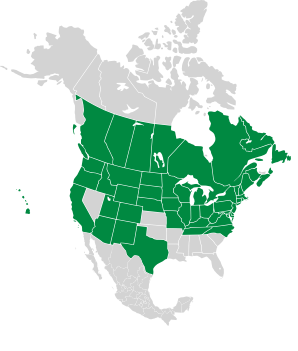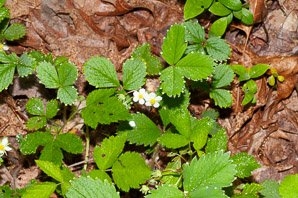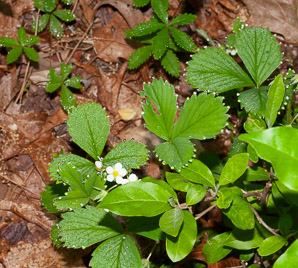
|
Fragaria vesca L. Alpine strawberry, white strawberry
Wild strawberries are common worldwide, throughout the northern hemisphere, in a wide range of habitats. They are members of the rose family. Identification: Wild strawberries have the characteristic shape and outer “seeds” of their cultivated brethren, but they are much smaller: up to ⅜″ (1 cm). And they may not be red in color. All strawberries go from green to white before ripening to red, but some wild strawberries lack a protein called Fra a1, which is necessary for them to turn red. White strawberries that look and feel ripe probably are. Regardless of berry color, wild strawberries are dotted with tiny “seeds,” called achenes. The achenes are actually tiny berries, each containing a thin fruity outer pulp and a large seed. Plants are low-growing, typically 3-6″ (7.6-15 cm) tall. Leaves occur in groups of three; each leaflet is ½-2½″ (1.5-6.3 cm) long. Flowers are white, about ½″ (1.5 cm) across. Wild strawberries are similar to common strawberries, and look a little like distantly related mock strawberries and barren strawberries. If the flowers are light pink or hot pink, you probably have a cultivated variety: |
5/21/2010 · Nashua River Rail Trail, Groton, Massachusetts · ≈ 9 × 6″ (23 × 15 cm) 5/21/2010 · Nashua River Rail Trail, Groton, Massachusetts · ≈ 11 × 7″ (27 × 18 cm) Though usually red, some varieties produce white fruits. · 6/20/2010 · Stan and Connie Kent, Falmouth, Maine · By Constance B. Kent |
||||||||||||||||||||||||||||
|
| |||||||||||||||||||||||||||||
Duchesnea indica |
Fragaria ‘Red Ruby’ |
You are here Fragaria vesca |
|||||||||||||||||||||||||||
|---|---|---|---|---|---|---|---|---|---|---|---|---|---|---|---|---|---|---|---|---|---|---|---|---|---|---|---|---|---|
| Common Name |  |
 |
 |
||||||||||||||||||||||||||
| Plant | Plants are 2-5″ (5-12 cm) high. | About 5″ (12 cm) high and 1-2′ (30-60 cm) around. | Plants are low-growing, typically 3-6″ (7.6-15 cm) tall. | ||||||||||||||||||||||||||
| Flowers | Flowers are yellow, with five petals, about ½-¾″ (1.3-1.9 cm) in diameter. They flower from April to August. | Deep pink, about ¼-¾″ (8.3-19 mm) in diameter, with five petals. | Flowers are white, about ½″ (1.5 cm) across. | ||||||||||||||||||||||||||
| Leaves | Leaves are in groups of three, dark green, heavily veined beneath, with rounded teeth. They are oval to elliptic, ¾-3″ (1.9-7.6 cm) × ¼-1½″ (8.5-38 mm), and hairy. | Dark green, in groups of three, glossy. | Leaves occur in groups of three; each leaflet is ½-2½″ (1.5-6.3 cm) long. | ||||||||||||||||||||||||||
| Fruit | Red berries are ¼-½″ (6.3-12 mm) in diameter, more spherical than strawberry-like in shape. The seedlike achenes on the berry are prominently raised, making the fruit resemble a tiny land mine. | Occasionally produces fruit. | Up to ⅜″ (1 cm) across. Red or white in color. | ||||||||||||||||||||||||||
| Range/ Zones |
|
|
|
||||||||||||||||||||||||||
| Habitats | Sun to light shade; well-drained soil | ||||||||||||||||||||||||||||
| Type | Wild | Cultivar | Wild | ||||||||||||||||||||||||||
Fragaria virginiana
Waldsteinia fragarioides


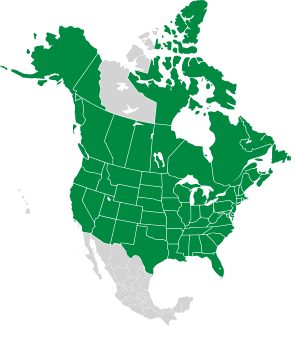
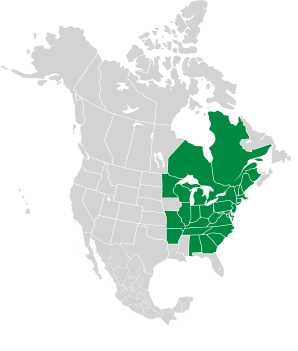
Edibility: Wild strawberries were the first variety to be cultivated and sold. They are delicious, much more flavorful than today's cultivated varieties. Eat them raw, prepare jams, or use them anywhere you would use grocery store strawberries. The dried leaves make a tasty tea.
Online References:
Plants for a Future, a resource and information centre for edible and otherwise useful plants
Bjørn Rørslett/NN's Nature Photography site
The USDA Forest Service's Fire Effects Information Database
References:
6/3/2021 · Widgeon Cove, Harpswell, Maine · ≈ 7 × 4½″ (16 × 11 cm) 
Fragaria vesca description by Thomas H. Kent, last updated 13 Oct 2021.
© FloraFinder.org. All rights reserved.
5/21/2010 · Nashua River Rail Trail, Groton, Massachusetts · ≈ 11 × 7″ (27 × 18 cm) ![]() ID is dubious
ID is dubious 
Range:
